We’re going to take you through some effective shipping methods and strategies, and show you ways to reduce costs by finding the right partners and using the best software (like Brightpearl).
Basics of Shipping
We’re sure you already know some of this, but it’s worth going over the basics and looking out for ways to keep your shipping costs low. It’s also worth listing all your product weights and sizes, as well as the most common locations for customer orders, so that you have somewhere to start when choosing a carrier.
Volume
Volume means either the quantity of products you ship, or the size of the individual products. Either way, it’ll make a difference to your costs, so use your sales and customer data to help you predict shipping volume in advance.
Small business owners obviously send out fewer packages than large stores, but there are perks to being small. Many shipping services and third-party fulfillment providers offer small business shipping discounts on delivery and packaging. And, as your order volume increases, you can take advantage of bulk rates.
Weight
The weight of each package will also affect the price of shipping—including its dimensional weight (DIM). This is a pricing model based on the parcel’s shape and size, as well as its weight, and most major carriers use it to calculate the cost. Typically, large light parcels cost more than smaller, heavier ones.
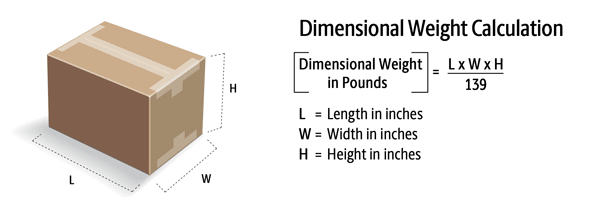
Source: ups.com
Shipping companies may also offer flat-rate shipping, which is when you’re charged a set price for a shipment, regardless of its actual weight. Flat-rate boxes are usually available for free from the USPS, UPS, or FedEx.
Priority
Another cost implication is the priority level. Most carriers have options including standard ground shipping, express, and overnight delivery, and it’s a good idea to offer multiple shipping methods to your own customers. 88% of consumers don’t mind paying for faster delivery on urgent orders.
Packaging
Any packaging adds extra weight, but it’s vital that your products are properly protected. Finding the perfect balance is another thing that small firms have to navigate. You also have to think about sustainability (66% of shoppers say they consider this when making a purchase).
If you only sell one type of product, it’s simple to figure out packaging costs, but it’s trickier with a range of different items or one-offs. You may also want to use branded packaging if image is a big part of your business.
Delivery Time
The time it takes for a parcel to travel from your facility to the customer will depend on the destination, but also on your shipping carrier and method. If you promise a customer that their order will arrive by a specified time, you need to be sure that it will happen!
To provide accurate delivery times, factor in lead times from your supplier and make sure your order fulfillment process is streamlined in order to ship as fast as possible and avoid errors.
Destination
The final factor to consider is the destination, and how far away it is from your fulfillment center. The further the parcel has to travel, the more it’ll cost. Shipping carriers divide geographical areas into zones (the US has eight), and you can reduce costs by minimizing the number of zones your shipment travels through.
Shipping rates may be different for commercial and residential addresses, and there may be surcharges for weekend or rural delivery. International shipping, of course, is more expensive.

Source: nosto.com
Shipping Solutions for Small Businesses
From private carriers like FedEx and DHL to the good old USPS, there are plenty of shipping partners to choose from. And you don’t have to pick just one—you might find it’s cost-effective to use a private carrier for part of the way, and USPS for last-mile delivery.
Alternatively, you could use a shipping platform like Shipstation or Shiptheory (both of which integrate seamlessly with Brightpearl). You’ll need to do your own comparison based on your specific needs, but here’s a flavor of what the major players offer to small businesses.
USPS
The United States Postal Service is often the cheapest option compared to other major carriers, and offers a variety of services for smaller firms including volume discounts and postage calculation tools.
The Click-N-Ship feature lets you pay postage and print labels online, and the Pickup service means you don’t have to visit the post office. You can reserve a PO Box so that business mail doesn’t come to your house, and get a free Priority-Mail Starter Kit. USPS also offers cubic pricing, which enables lower rates for items with small shipping volume (under 20lb) through USPS Priority Mail.
UPS
UPS provides several small business shipping solutions, such as “UPS Connect” which gives you free brainstorming sessions on your business plan and shipping needs. UPS can even help you get discounts for other areas of your business, including accountancy and marketing.
There are financial and payment services for managing shipping costs, plus handy services like scheduled pickups and returns management. UPS also has an eFulfillment service to help you store and ship products sold on more than 20 platforms.

FedEx
FedEx also provides services for small companies, with support such as grants and admin assistance as part of an e-commerce center to help online businesses develop. There’s also a useful FAQs hub and glossary of packaging terminology, plus a dimensional weight calculator.
You can schedule pickups, and print custom postcards or coupons to include in parcels. If you sign up for a My FedEx Rewards account, you’ll be rewarded the more you ship. And for perishable items, FedEx offers temperature-controlled shipping packages with cold and heated options.
DHL
DHL is known for its international delivery services, but that doesn’t rule out small businesses—the carrier aims to help you engage in global trade with a range of services. Fill out a shipping profile on their website and discuss your needs with an expert.
DHL Parcel International Standard includes simplified postal customs clearance, reliable transit times and end-to-end tracking, while DHL Express promises delivery by the end of the earliest possible business day. In the US, DHL also partners with the USPS for expedited shipping.
Ways to Reduce Shipping Costs
No matter which carrier you use, the cost of shipping will be based on the dimensions and weight of the items, the delivery speed, and the distance between origin and destination. The speed of delivery is your choice (or that of your customers), but there are opportunities to reduce costs for the other aspects.
Negotiate
Don’t be afraid to negotiate with major carriers—they’re used to it and you may find them more receptive than you think. If you regularly ship large volumes, they’ll be glad of your custom and happy to give you a deal on bulk shipping. And, as we’ve already mentioned, smaller businesses can often enjoy special discounts while they grow.
Although sticking with one carrier keeps things simple, it can be more cost-effective to negotiate favorable rates with a number of providers. For example, you could use one firm for local delivery and another for country-wide shipping.
Affordable Packaging
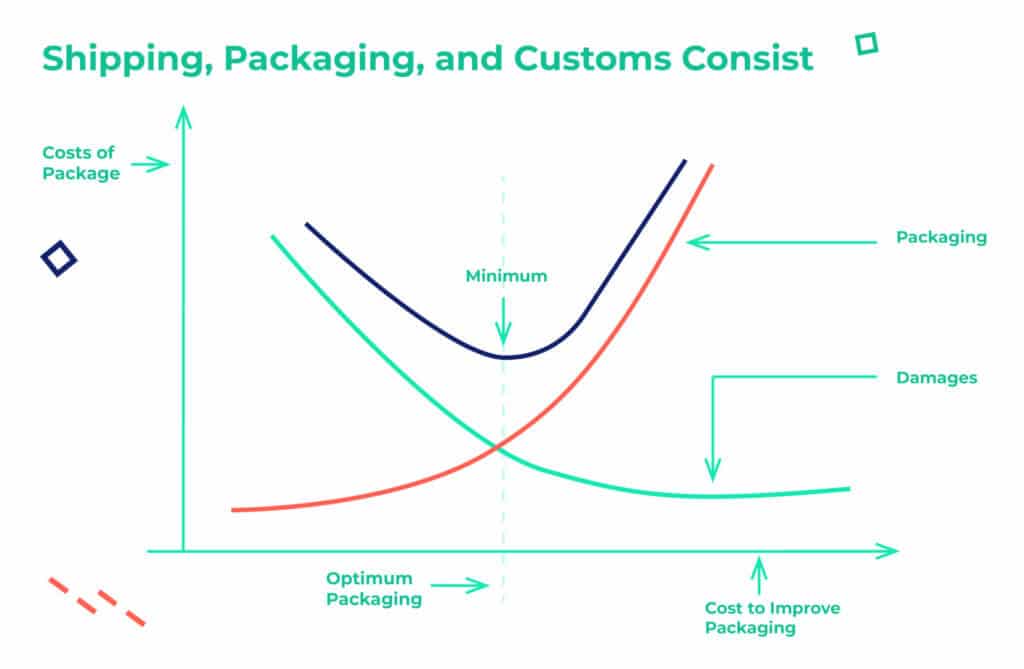
Source: manufacturinghub.io
The cost of packaging can quickly add up—especially if you don’t pay attention to the weight. Try to use lightweight options such as corrugated boxes, air pillows, packing paper, and bubble wrap. Pack items tightly together if you can, and consolidate orders in one package to use fewer boxes.
If all your products are a similar size, you can buy packaging in bulk. You can reuse good-quality boxes and packing material, so don’t throw anything out when a new delivery arrives from your supplier!
Outsource Shipping
Shipping can be a time-consuming task—your business may not have the resources to carry out every task in-house, and you’ll soon run out of space to store your stock. One option is to outsource shipping to a third-party logistics (3PL) provider or a dropshipper.
3PL companies are logistics experts and can easily manage shipping and returns on your behalf. They often offer extra services like order management, usually from a network of fulfillment centers. If you don’t want the whole nine yards, try a hybrid shipping strategy using both in-house and 3PL or dropshipping services.
Warehouse Location
When you’re aiming to reduce the cost of delivery, there’s no point having a warehouse that’s nowhere near your customer base—your parcels would have to travel through multiple zones and you’d have to fork out for expedited delivery on urgent orders.
Even for small businesses, it makes sense to own or rent warehouse space in several strategic locations and split your stock between them, so that parcels travel a shorter distance. (If you’re taking the multi-warehouse approach, it’s easy to manage transfers and inventory with Brightpearl.)
Qualities of the Right Shipping Partner
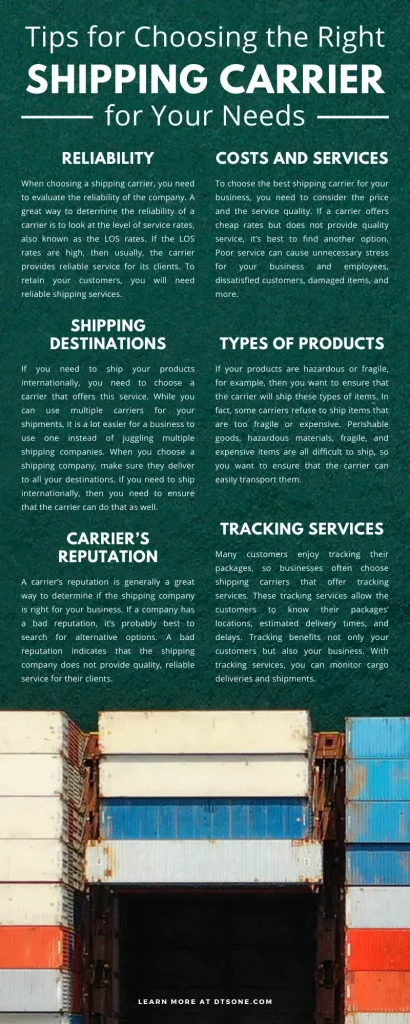
Source: dtsone.com
Every business has unique needs, so do your research and select a reliable, trustworthy partner who offers all the services you require.
Dropshipping
A dropshipping partner is a firm that handles your shipping, without you having to store or process any inventory yourself. The dropshipper, usually a manufacturer or wholesaler, ships orders direct to the customer.
By cutting out the middleman, dropshipping helps you reduce the costs of storage, transportation, and labor. However, you’re relinquishing control, so make sure your partner shares your commitment to customer service.
You could decide to use dropshipping only for your larger products to save on space, and store and ship smaller items yourself.
Networking
It’s crucial to choose shipping partners with whom you can build strong relationships and find the right balance of price and convenience. As with all partnerships, good communication is vital—they should be willing to share information so that you know in advance about any supply chain issues.
You want to minimize both costs and delivery times, so look for partners in the areas closest to your customer base. As we’ve mentioned, there’s no need to pick just one. You can negotiate deals with several companies, or use existing hybrid arrangements such as FedEx SmartPost and UPS SurePost, both of which hand your package to the USPS for last-mile delivery.
Packaging
As well as getting a fair deal on shipping rates, you’ll want to work with a partner who advises you on the best packaging and how to calculate costs. For example, FedEx and UPS use the dimensional pricing model, so you’ll be aware that you need to optimize your packaging to save money.
All the major carriers offer flat-rate shipping, where you use carrier-provided, standard packaging. And they usually give you free standard packaging, which is great for small businesses. Even if not all your products will fit into standard boxes, you can save money by using it for some orders.
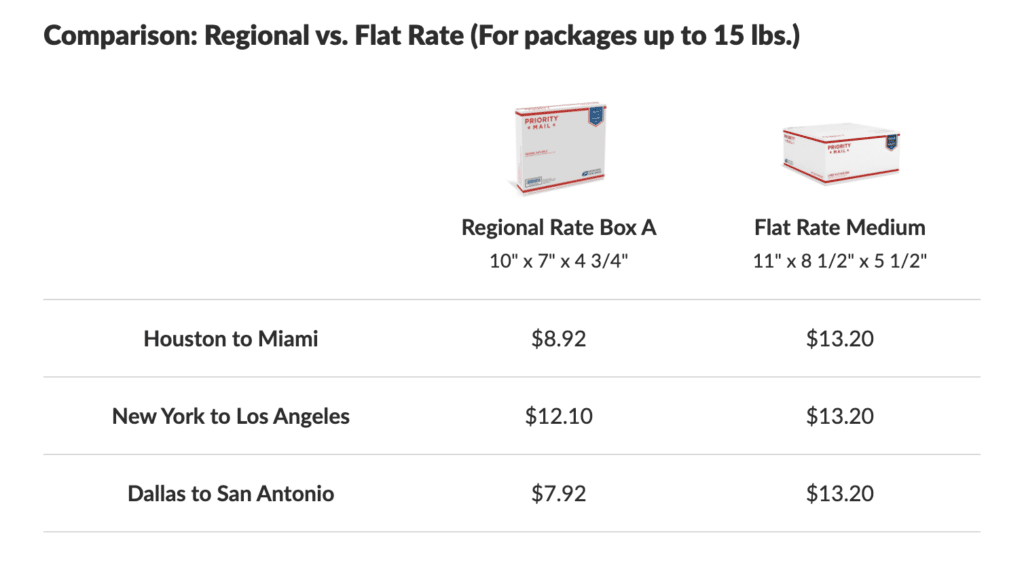
Source: ecwid.com
Technology
Technology makes it much easier to manage the shipping process, so look for a shipping partner who uses advanced tools to track shipments and sync that information with your own business systems.
For example, the right software will ensure you receive real-time updates each time a package is dispatched, plus data on its estimated delivery time. If you work with a 3PL, they will have a computer system that streamlines all processes and provides analytics to help you make decisions.
How to Charge Your Customers
Figuring out how much to charge your customers for shipping is a challenge for small businesses. If you tempt them with free shipping, how will you offset the cost? Is it viable for you to provide next-day or two-day delivery? What about international customers?
If your shipping costs are seen as too high, it may cause people to abandon their shopping cart—whereas one study shows that companies can increase orders by 90% by offering free shipping.
Whatever you decide to do, it’s important to display your shipping policy clearly on your website. Putting a guarantee on your shipping will reassure your customers that you are able to meet their expectations and will fix any problems that might occur.
Free Shipping
Free shipping is beloved by all customers. Many people are willing to wait a little longer for non-urgent orders if the delivery is free. Often, they’re even prepared to add extra items to their cart just to qualify for free shipping.
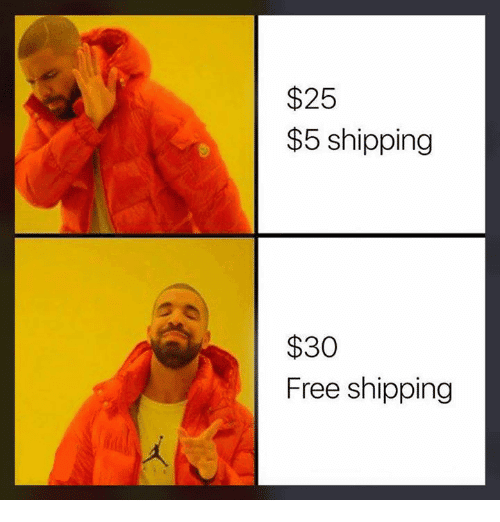
Source: me.me
But if you offer this option, who’s going to pay for it? You can either pass on the costs to customers by baking it into the price of your products, or agree to bear the cost yourself, which may mean making cuts elsewhere in the business. Look carefully at your budget, sales figures, and customer data to help you decide.
You may find it cost-effective to set a minimum order value for free shipping, and promote small add-ons for larger items so that it’s easy for customers to top up the total price. Performing A/B testing will help you understand your customers’ preferences.
Flat-rate Shipping
Flat-rate shipping is also appealing, because shoppers can order as much as they want without seeing the total rise exponentially as they add to their cart. As well as covering various sizes and weights, a flat rate can also make the cost of long-distance shipping the same as local delivery.
If most of your parcels are the same size, and most of your custom comes from a specific region, flat-rate shipping can work well for you. If not, you’ll find yourself shouldering extra costs (or hiking up your product prices). The flat rate should be high enough to cover more expensive deliveries.
However, you don’t have to set one flat rate for everything—you can offer a different price for different service levels. And flat-rate shipping helps your business convert variable costs into fixed costs.
Real-time Rates
Free and flat-rate shipping don’t take into account the fact that carrier rates can fluctuate, based on events in the global supply chain. And while a good shipping partner should update you regularly on price changes, it’s time-consuming to keep changing the information on your website.
Another option is to offer real-time rates, which update automatically so that your customers always see the current information. This involves integrating your system with that of your shipping carrier so that the prices are pulled in and displayed on your site at checkout.
Shipping Strategies for Small Businesses
There are a number of strategies you can use to optimize shipping, including outsourcing and using specialized software. It’s a good idea to evaluate your shipping strategy regularly to ensure that it’s working for you.
Multi-channel
Today’s customers demand the convenience and choice of multichannel retail—and the more channels you operate, the more you can sell. This includes your own physical and online stores, e-commerce marketplaces like Amazon, eBay, and Shopify, or even selling via social media.
If you’re selling with a marketplace, make sure you check the criteria carefully to know what you can and can’t sell, as well as any other rules (for instance, you can’t use your own packaging with Amazon). You also need to deliver accurate shipping information, as too many errors can get you kicked off the platform.
Fulfilling orders from multiple channels obviously makes your logistics more complex, including returns management. You need to keep a close eye on your inventory and sync data between all channels. Brightpearl helps you do this, as well as setting different shipping methods for different channels.
Multi-carrier
As we mentioned earlier, it can be cost-effective to mix and match your shipping partners in order to find the best deals for various package types and destinations. Most small businesses work with two or more carriers for this reason. If you keep an up-to-date record of your product weights, you will find it easier to make comparisons.
When it comes to choosing carriers, it’s not just about the lowest rates—look for those offering guaranteed delivery times and robust insurance to cover you for any delays or damage. Evaluate your relationships regularly to make sure everything’s working smoothly, and renegotiate if necessary.
Outsource
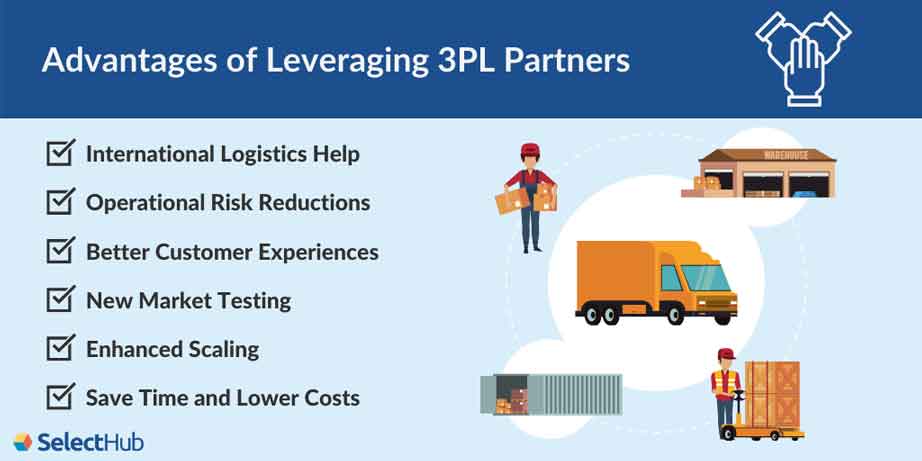
Source: selecthub.com
For small businesses with limited resources, it can make sense to outsource some or all of your operations to a third-party logistics provider. This might be just shipping, or the entire fulfillment process. And it could be for all your products or just some of them.
Thanks to the 3PL’s expertise, you should be better able to manage your customer experiences. But you’ll also have to give up control, which can be hard when you’ve built the business from scratch. It’s vital that you select a trusted partner, and that you ensure your budget allows for the cost of outsourcing.
Shipping Software
As well as finding a carrier who uses the best technology to ensure swift and accurate shipping, your business needs its own software to help you streamline your in-house operations and share critical data with your partners.
Look for something that enables you to create smooth workflows using automation, and gives you real-time insights into every corner of the business from inventory to shipping. You could choose a standalone solution, or go for a complete retail operating system that incorporates shipping and fulfillment tools.
Optimize Shipping With Brightpearl
As an all-in-one retail operating system, Brightpearl is an affordable way for smaller businesses to get the tools they need—including features designed for a smooth shipping process. Thanks to the powerful Automation Engine, you can save a ton of time on things like creating shipping labels, pick lists, packing slips, and customs forms.
You can set the system to select the most suitable carrier based on order type and weight, and ship items differently according to their sales channel. Brightpearl also lets you create dropshipping rules for specific customers, channels, or products. It’s easy to automate multi-channel, multi-warehouse, or order splitting for partial fulfillment.
The platform has integrations with all the major carriers (as well as Amazon FBA and 3PL providers), so you can mix and match to get the best deals, and offer your customers flexible shipping options. It’s easy to manage and communicate with your partners, sharing and syncing data to avoid errors or last-minute changes.
Meanwhile, the Inventory Planner tool enables you to pull in CBM weight information so that it displays on your purchase orders. You can always see how heavy each package will be, and figure out the most cost-effective way to ship it. It also helps with working out your landed costs.
Benefits of Using Brightpearl
Here are a few more reasons for choosing Brightpearl:
Productivity
With automation replacing most manual tasks, you’ll save time and reduce errors. For example, barcode scanners make it easy to log new deliveries, locate products in the warehouse, and fulfill every order correctly. Plus, with all your tools (and integrations) in one platform, there’s no time wasted on toggling between different apps.
Visibility
Brightpearl gives you real-time insight into the status of your inventory, orders, and finances. Data from all sales channels, warehouses, customers, and suppliers is housed in a central hub and synced instantly when orders are picked, packed, and shipped. Ensure your stores are showing accurate stock availability, get replenishment alerts, and spot any problems early.
Forecasting
This visibility makes it much easier to avoid stockouts and excess stock, and to plan ahead. Use the reporting and analytics tools to view sales history and product performance. Work out the most popular areas for orders and make sure you have a warehouse or fulfillment partner nearby—then you can set shipping rates accordingly.
Customer-centric
Brightpearl includes a retail-focused CRM, so you can keep tabs on customer preferences and behaviors. You can even reward your best customers by offering them faster shipping or automatically adding free gifts to orders. And the POS system helps you satisfy shoppers by checking availability, fulfilling orders from alternative locations, or placing backorders.
Grow Fearlessly
Your business may have started small, but Brightpearl shares your ambitions to expand—and your dedicated Customer Success Team will be with you every step of the way. The SaaS subscription model is scalable and flexible, so you can adjust your tech stack as required. Plus, there’s 24/7 support, training, and implementation.
Final Thoughts
Your customers expect flexible shipping options, and preferably fast and free delivery! They also expect their items to arrive on time and in optimum condition: 58% of customers globally have stopped shopping with a retailer after a negative shipping experience.
Although it’s harder for small businesses to compete with the likes of Amazon, you can keep customers happy and keep costs down by being smart about packaging and warehouse locations, working with the right partners, and using the right software (such as Brightpearl) to streamline your shipping and fulfillment process.
